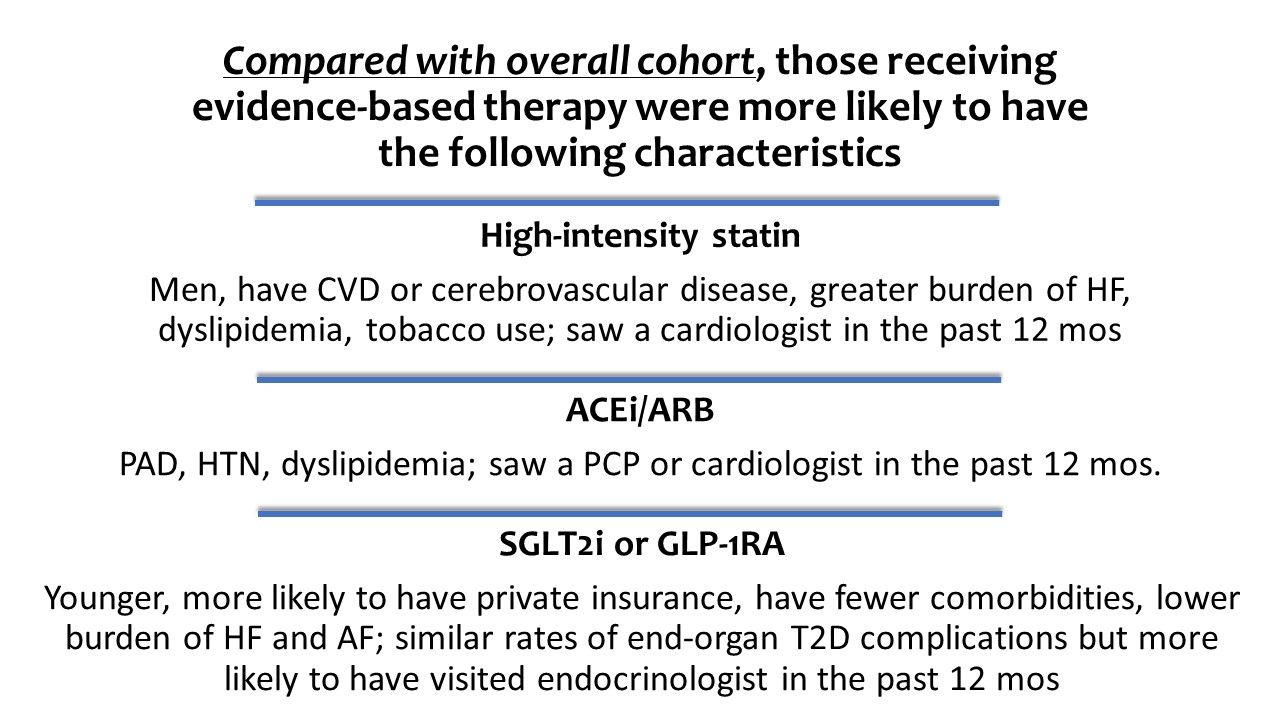- CDC
- Heart Failure
- Cardiovascular Clinical Consult
- Adult Immunization
- Hepatic Disease
- Rare Disorders
- Pediatric Immunization
- Implementing The Topcon Ocular Telehealth Platform
- Weight Management
- Monkeypox
- Guidelines
- Men's Health
- Psychiatry
- Allergy
- Nutrition
- Women's Health
- Cardiology
- Substance Use
- Pediatrics
- Kidney Disease
- Genetics
- Complimentary & Alternative Medicine
- Dermatology
- Endocrinology
- Oral Medicine
- Otorhinolaryngologic Diseases
- Pain
- Gastrointestinal Disorders
- Geriatrics
- Infection
- Musculoskeletal Disorders
- Obesity
- Rheumatology
- Technology
- Cancer
- Nephrology
- Anemia
- Neurology
- Pulmonology
In Patients with T2D and ASCVD, Prescriptions for Evidence-based Therapies Far from Adequate
US patients at high CV risk do not receive adequate evidence-based pharmacotherapy, according to large multisite cohort analysis.
©18percentgrey/stock.adobe.com

More than one-third of patients with both type 2 diabetes (T2D) and atherosclerotic cardiovascular disease (ASCVD) in a large representative US cohort were receiving none of the 3 primary, evidence-based therapies associated with cardiovascular benefit, according to findings published Feb 17 online in JAMA Network Open.
The guideline-recommended lipid-, blood pressure-, and glucose-lowering therapies investigated in the study were high-intensity statins (atorvastatin 40 - 80 mg or rosuvastatin 20 - 40 mg), angiotensin-converting enzyme inhibitors (ACEI) or angiotensin-receptor blockers (ARB), and sodium-glucose cotransporter-2 inhibitors (SGLT2i) or glucagon-like peptide-1 receptor agonists (GLP-1 RA).
The research team, led by Christopher B. Granger, MD, professor of medicine and nursing at Duke University and at the Duke Clinical Research Institute, report further that fewer than 1 in 20 patients were receiving all 3 therapies, just one-quarter were prescribed a high-intensity statin, less than half were prescribed an ACEI or ARB, and fewer than 1 in 15 patients were prescribed an antihyperglycemic agent with CV benefit.
Granger et al note that the “data suggest that previously described gaps in the use of evidence-based therapies for individuals with diabetes and ASCVD in selected environments extend to this large, distributed network of health systems across the US,” and highlight the need to ensure research is better translated into clinical practice for the majority of US patients with T2D and ASCVD.
The multicenter cohort study used health-system level aggregated data from the US National Patient-Centered Clinical Research Network (PCORnet). The defined study period ran from January 1 through December 31, 2018 and included patients ≥18 years with evidence of diabetes and ASCVD and at least one health encounter during the year of the study. Data were analyzed between September 2020 - January 2021.
ASCVD was defined by the presence of coronary artery disease (CAD), peripheral arterial disease (PAD), or cerebrovascular disease. Demographic data collected from the existing medical record included race and ethnicity. Investigators also retrieved data on comorbidities, active smoking status, and a range of laboratory studies (ie, lipid profiles, estimated glomerular filtration rate (eGFR) and hemoglobin A1c (HbA1c).
From 12 geographically diverse health systems, Granger et al identified 561 259 eligible patients for which complete medical information was available for 324 706, comprising the final cohort.
Mean age for the cohort was 68.1 years, 44.4% were women; racial/ethnic distribution of the group was 64% White, 18.2% Black, 12.3% Latinx, and 2.8% Asian. CAD was identified in 73%, PAD in 46.7%, and cerebrovascular disease in 18.5%. There were 205 885 patients with specialized visit data that showed during the study period 8.7% visited an endocrinologist, 26.4% visited a cardiologist, and 74.8% visited a primary care physician.

Use of evidence-based pharmacotherapy is low
Lipid-lowering. When the investigators analyzed use of evidence-based treatment for T2D and ASCVD, they found that although 58.6% of patients were prescribed a statin, a high-intensity statin was recommended for just slightly more than one-quarter, 26.8%.
Non-statin lipid-lowering agents also were used, but at extremely low levels. According to the study, ezetimibe was prescribed for 2.5% of patients and a PCSK-9 inhibitor for <1%.
BP-lowering. For treatment of hypertension, Granger et al found that less than half (45.5%) of the patients received either an ACE or an ARB.
Glucose-lowering. Just slightly more than one-third of the cohort, the team reports, was prescribed metformin (37.2%) and insulin (36.5%), and sulfonylureas were prescribed for 12.9%.
When they looked at extent of the use of evidence-based therapy from the 3 classes of risk-mitigating treatments for the full cohort the researchers found:
- 42.6% were prescribed none of the agents
- 31.9% received a medication from 1 class
- 21% were prescribed agents from 2 medications classes
- 4.6% were prescribed drugs from all 3 classes
"These estimates of evidence-based therapy prescription are considerably lower than those observed in other recent analyses in selected populations," write Granger and colleagues in their conclusion. "These findings amplify the need to close these critical gaps between evidence generation and clinical practice for most patients in the US with diabetes and ASCVD."
Reference: Nelson AJ, O'Brien EC, Kaltenbach LA, et al. Use of lipid-, blood pressure-, and glucose-lowering pharmacotherapy in patients with type 2 diabetes and athersclerotic cardiovascular disease. JAMA Network Open. 2022;5:e2148030.
